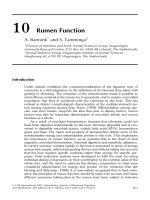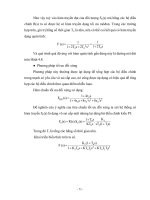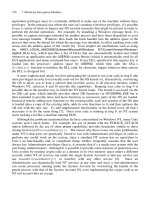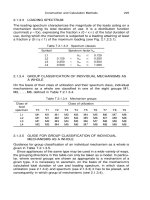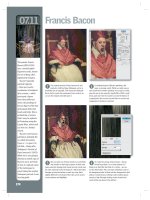presentation zen Simple ideas on presentation design and delivery phần 8 docx
Bạn đang xem bản rút gọn của tài liệu. Xem và tải ngay bản đầy đủ của tài liệu tại đây (3.1 MB, 24 trang )
160 Presentation Zen
The slide on the left looks busier due to
the abrupt contrast between the
background color of the images. By
aligning the text and the photos and
making the image backgrounds
transparent (in this case by simply
changing the slide background to white)
the slide is much cleaner and "noise" is
reduced.
The background image on the slide on
the left has too much salience, making
the title hard to see. Choosing a more
appropriate background image that
allows the text to remain clearly in the
foreground and grouping the text lines
makes for a stronger title slide
By making the background of the fish
photo seem transparent (again by
changing the slide background color in
this case) the image and text blend
together harmoniously into a more
unified visual.
The slide on the left has a busy template
which makes the useful area of the slide
about 113 smaller. The slide on the right
uses the image to cover the entire slide.
The text is clearly foreground and the
image serves both as background and at
times foreground, making the overall visual
more dynamic and more unified with a
cleaner, more dramatic look.
Chapter 6 Presentation Design: Principles and Techniques 161
This slide features a typical graph exported from Excel.
It is impossible to identify the countries as the text is too
small and at an angle. The biggest problem is this is too
much data for a display. This amount of information
would be better presented in a handout.
The text and data are easi
er to see as the contrast
between the foreground and background is much
better. Only the key variables are chosen to include in
the display, which allows the bars and figures to be
larger. Information on the excluded variables can be
put into a document to be taken away.
The background color is not a good fit with the colors
of the bars nor does it provide enough contrast; the
:ext is hard to read. The background of the sushi
photo adds unnecessary noise to the visual.
Here the background
of
the sushi ph
oto
"disappears" to match the white background of
the slide. The text and bars and background
have much better contrast and are easier to read.
The more strikingly visual your
presentation is, the more people will
remember it. And more importantly,
they will remember you
- Paul Arden
162 Presentation Zen
In Sum
Design matters. But design is not about decoration or about
ornamentation. Design is about making communication as easy and
clear for the viewer as possible.
Keep the principle of signal-versus-noise in mind to remove all
nonessential elemen
ts. Remove visual clutter. Avoid 3-D effects.
People remember visuals better than bullet points. Always ask yourself
how you can use
a strong visual—including quantitative displays—to
enhance your narrative.
Empty space is not nothing; it is a powerful something. Learn to see
and
manipulate empty
space to give your slide designs greater
organization, clarity, and interest.
Use the principle of contrast to create strong dynamic differences
among elements
that are different. If it is different, make it very
different.
Use the principle of repetition to repeat selected elements throughout
your slides. This c
an help give your slides unity and organization.
Use the principle of alignment to connect elements visually (through
invisible lines)
on a slide. Grids are very useful for achieving good
alignment. This will give your slide a clean, well-organized look.
Use the principle of proximity to ensure that related items are grouped
together. People wi
ll tend to interpret items together or near to each
other as belonging to the same group.
Chapter 6 Presentation Design: Principles and Techniques 163
Sample Slides:
Images & Text
In this chapter you can review slides from several different presenters who make
presentations often in the real world." (Because of limited space, only a small number of
slides are shown from each presentation.) Not all of the simple slides are necessarily
perfect. However, while we can judge a slide in terms of its adherence to basic design
principles, it is difficult to judge the effectiveness of a slide design without seeing how the
visuals are used in a live talk.
Though the content and circumstances are different in each case, what the slides in this
chapter have in common is that they are simple, highly visual, and served (or could serve)
a successful supportive role in a live talk, augmenting the presenter's narrative and
helping to make things clear.
Your slides should be engaging and "part of the show," but they must also be easy to
understand quickly. If you need to explain something quite complex, then build (animate)
the parts of your chart or diagram in steps in a way that is logical and clear. Simplicity,
restraint, and harmony are important considerations when designing slides or other
multimedia. The goal is not to make slides "look good." The goal is clarity. However, if you
design slides while always mindful of the principles of simplicity and restraint as well as the
basic design concepts outlined in Chapter 6-your slides will indeed look attractive.
Chapter 7 Sample Slides: Images & Text 165
Differentiation
Here you can see the first 34 slides (out of over 100) for a
presentation I did on this issue of branding and transformation. The
client a major international financial firm—asked me to focus on
differentiation and engagement. The 35-minute presentation also
featured a few short video clips to underscore my points. As I spoke,
the slides appeared behind me on a huge back-lit screen, though I
rarely glanced at the screen. I had some quotes and I had some
visual examples of what I was talking about. But most of all, I had a
point, and I had stories and examples to illustrate that point. The
slides provided an important and supportive backdrop that amplified
my message and made it stronger.
166 Presentation Zen
Chapter 7 Sample Slides: Images & Text 167
Shift Happensk
Jeff Brenman
Founder and CEO, Apollo Ideas
www.apolloideas.com
The slides in this pre
sentation feature a stylization of a
slideshow originally created by Karl Fisch, examining
globalization and America's future in the 21st century. It's
designed for on-line viewing. However, in a live talk some of
the text could be removed, making the slides a better
complement to the speaker's words. You can find all the
slides used in this presentation on Slideshare.net:
www.slideshare.net/jbrenman
An official update to the original Shift Happens video
presentation from
Karl Fisch and Scott McLeod can be seen
on Wikispaces.com:
www. shiffthappens.wikispaces.corn
168
Presentation Zen
Chapter 7 Sample Slides: Images & Text 169
170 Presentation Zen
The Sustainable Food Lab*
Chris Landry
Director of Development & Communications
Sustainable Food Laboratory
www.sustainablefoodlab.org
The slides here are part of a modified slide deck
Chris Landry uses for talks about his organization
and the work they do to bring more sustainability
to mainstream food systems. Chris added a bit
more copy to these slides so they will make a
little more sense when viewed without narration
in printed form, but the visuals were originally
created to augment his live talk. You can find all
the slides used in this presentation on
Slideshare.net:
www.slideshare. net/chrislandry
Chapter 7 Sample Slides: Images & Text 171
172 Presentation Zen
Truemors
Guy Kawasaki
Co-founder of Truemors
www.truemors.com
The slides here were used by Guy Kawasaki in a
presentation entitled How I Launched a Web 2.0, User-
Generated Content, Citizen Journalism, Long-Tail,
Social Media Site for only $10,918.09 (which may be the
world's longest title for a pitch). In his own charismatic
way Guy revealed a number and then elaborated on the
meaning of the figure. The slides are not meant to
stand alone though you can get the gist of his main
points from the slides. In the live talk the simplicity of
the slides was a good complement to the spoken word.
You can find all the slides used in this presentation on
Slideshare.net:
www. slideshare.net/GKawasaki
The slides were created by Scott Schwertly of
Ethos3 Communi
cations (www.ethos3.com).
Chapter 7 Sample Slides: Images & Text 173
My Declaration of
Independence
Pam Slim
Speaker, coach, business consultant
www.escapefromcubiclenation.com
The few slides here are from a longer presentation called
My Declaration of Independence that Pam Slim and her
team designed to be used in live presentations and also for
an inspirational piece done in Flash and set to music
available on her Web site. For the live talk, Pam can
remove more of the text so that the slides complement her
words.
You can watch the Flash version of this presentation on
Pam's corporate site, Ganas Consulting:
www.ganas.com
Aromatic Chemistry
Dr. Aisyah Saad Abdul Rahim
Lecturer in Pharmaceutical Chemistry School of
Pharmaceutical Sciences Universiti Sains Malaysia.
www.pha.usm.my/pharmacy/Aisyah2006.htm
The visuals here are typical of the lecture slides
now used by Dr. Saad in her Pharmaceutical
Chemistry classes in Malaysia. These are samples of
her lecture slides on "Aromatic Chemistry." The
black and red slides serve as a historical
introduction to benzene, whereas the second
group of slides illustrate the four essential features
of aromatic compounds.
"I teach 'Aromatic Chemistry' to pharmacy
students," says Dr. Saad. "Mindful of Asian
students' penchant towards rote learning, I
decided to apply the Presentation Zen approach in
my lectures. The first few lectures had the students
baffled because they could hardly jot down any
notes. Later, they figured out that they had to pay
more attention to my lectures. I use the
Presentation Zen approach because it appeals to
me visually and provides an amazing way to make
students listen and understand more in lectures
rather than just copying down notes off my slides."
174 Presentation Zen
Chapter 7 Sample Slides: Images & Text 175
176 Presentation Zen
Presenting on Animal-Based Issues
Sangeeta Kumar, M.Ed.
Education Coordinator
People for the Ethical Treatment ofAnimals
www.peta.org
In her position as Education Coordinator for
People for the
Ethical Treatment of Animals,
Sangeeta travels a lot giving highly visual
presentations on animal-based issues. The
sample slides on this page are from a
presentation called Animal Rights and Wrongs.
The slides on the opposite page are from her
talk called Vegetarian is the New Prius.
When dealing with a complex or controversial
issue, it is important to communicate your ideas
in a way that the audience can relate to and
visualize," Sangeeta says. In these examples,
rather than relying on bar graphs or heady
quotes, I use engaging photographs and easy to
understand facts to help the audience visualize
how their food choices impact animals and the
environment."
See more designs by Sangeeta on her
corporate Web site:
www.kumarideslgns.com
Chapter 7 Sample Slides: Images & Text 177
Chapter 7 Sample Slides: Images & Text 178
Inbox Zero
Merlin Mann
Productivity guru and creator of 43 folders
www.43folders.com
www.merlinmann.c
om
The slides here are just some of the ones used by
Merlin Mann in a talk he gave in the summer of 2007
at Google for their Tech Talk series. The presentation
was about strategies for dealing with high-volume
email and the importance of getting your inbox to
zero. These simple slides—created with images from
iStockphoto.com
—served as a good supportive
backdrop as he told his story. You can find a video of
Merlin's "Inbox Zero" presentation on YouTube and
Google Video.
In Sum
A good visual will enhance the speaker's message. The slides featured here are a very
small sample that highlight what's possible when you combine images and text. From a
technical point of view, these slides were not too difficult to produce. All that was needed
was PowerPoint or Keynote, and image editing software such as Adobe Photoshop
Elements. What you design your slides or other visuals to look like depends completely on
your unique situation and your audience, but keep the following in mind:
Create visuals that are simple with clear design priorities that contain
elements which guide the viewer's eye.
Have a visual theme but avoid tired, overused software templates.
Limit bullet points or avoid them completely.
Use high quality graphics.
Build (animate) complex graphics to support your narrative.
Think "maximum effect with minimum means."
Learn to see empty space, and learn to use it in a way that brings greater
clarity to visuals
.
Chapter 7 Sample Slides: Images & Text 179
Be here now. Be some place else later.
Is that so complicated?
- David Bader
